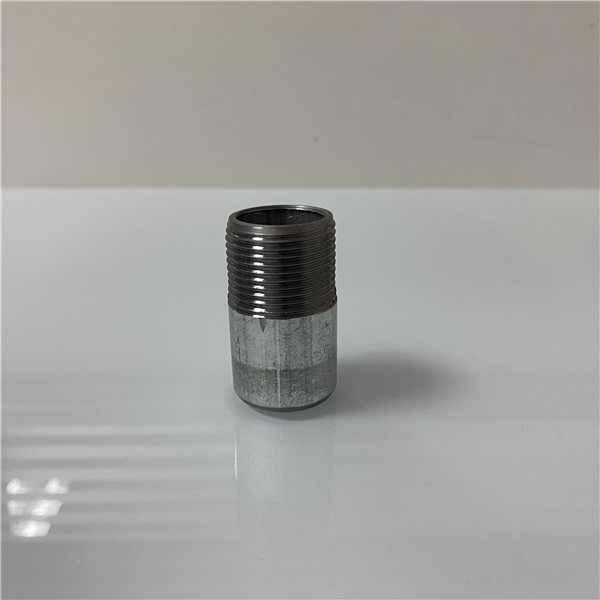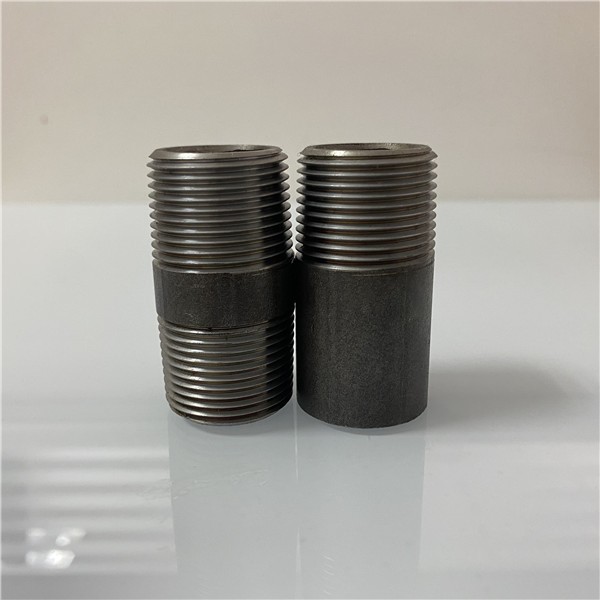The main difference between welded and seamless pipe nipples lies in the raw materials used, which directly impacts their pressure-bearing capacities. Next, we will discuss both types of pipe nipples, their differences, and their specific applications.
1. What Is a Welded Pipe Nipple?
 Welded pipe nipples are from flat pieces of carbon or stainless steel. The flat material is rolled into a cylindrical shape and then welded along the seam to create the pipe.
Welded pipe nipples are from flat pieces of carbon or stainless steel. The flat material is rolled into a cylindrical shape and then welded along the seam to create the pipe.
The welding process involves using a high-energy source to fuse the edges of the material. This type of pipe is a welded steel pipe, and the standard length of these pipes is typically 6 meters.
Key Characteristics:
-
Simple production process: The process is straightforward, raising production efficiency.
-
Variety of specifications: Welded pipes can be manufactured in various sizes and wall thicknesses, making them versatile for different uses.
-
Lower cost: Welded nipples are more affordable than seamless nipples due to their unfussy production process.
Weakness:
-
Weld seam: The seam on a welded pipe represents a potential weak point, which can reduce the pipe's durability under extreme pressure. As a result, welded pipes are generally less suitable for high-pressure applications.
Applications:
Welded nipples are typically in low-pressure applications, such as water and gas pipelines, heating systems, and industries where the mechanical demands on the pipes are relatively low.
2. What Is a Seamless Pipe Nipple?
 Seamless pipe nipples are by drawing or extruding a solid bar of carbon steel or stainless steel into a hollow shape.
Seamless pipe nipples are by drawing or extruding a solid bar of carbon steel or stainless steel into a hollow shape.
Unlike welded pipes, seamless pipes do not have a seam, which gives them superior pressure resistance and structural integrity.
Key Characteristics:
-
No seam: The absence of a seam eliminates the primary weak point found in welded pipes, making seamless pipe nipples stronger and more durable under high pressure.
-
Production methods: Seamless pipes through various processes such as hot rolling, cold rolling, cold drawing, extrusion, and piercing.
-
Wide range of shapes and sizes: Seamless pipes come in cross-sectional shapes, including round, square, and other irregular profiles. Their diameters can range from 0.3mm to 650mm, with the wall thickness varying to suit different applications.
Strength:
-
Higher pressure capacity: Seamless nipples are ideal for use in high-pressure environments, such as in the petrochemical industry, boilers, steam pipelines, and automotive applications.
Applications:
Seamless nipples in high-pressure liquid and gas pipelines, oil and gas exploration, and chemical processing due to their ability to withstand extreme conditions.
3. Differences Between Welded Nipples and Seamless Nipples
Appearance:
-
Seamless pipe nipples: These are smooth inside, with no visible seams, providing a more uniform surface for fluid flow.
-
Welded pipe nipples: A visible weld seam or rib runs along the inner surface, which may affect the pipe's flow characteristics.
-
Seamless nipples: Higher pressure resistance, making them suitable for demanding applications with high pressure and temperature.
-
Welded nipples: Generally have a lower pressure tolerance, around 10 MPa, but are sufficient for low-pressure uses.
Production Method:
-
Seamless nipples: Formed from a single piece of steel through rolling, and no welding is involved in their production.
-
Welded nipples: The steel is rolled into shape and then welded, typically using either spiral or direct welding techniques.
-
Seamless nipples: Due to their superior performance under pressure, seamless pipe nipples are expensive.
-
Welded nipples are cheap, but their performance is somewhat limited by the presence of the weld seam, making them less durable in high-pressure applications.
Applications:
-
Seamless nipples: Preferred for critical applications, such as oil exploration, gas pipelines, and industrial machinery, where high performance is necessary.
-
Welded nipples: Use in water, gas, and heating systems and where there is low demand for mechanical and pressures.
4. Summary of Applications
-
Seamless pipe nipples in industries such as oil and gas, chemical processing, and boiler systems are popular, where reliability and the ability to withstand extreme pressures and temperatures are critical.
-
Welded pipe nipples in residential plumbing, low-pressure heating, and general fluid transport systems are relatively common, where the stress on the piping is less severe.
5. Conclusion
In summary, seamless pipe nipples offer greater strength, pressure resistance, and durability. Welded nipples are more economical but better suited for less demanding applications. The choice between the two types of nipples depends on the project requirements, including pressure, temperature, and budget constraints.
For industries needing high-performance piping, seamless is often the preferred option. However, welded nipples still play a crucial role in many systems, especially in environments with lower pressures and budgets.
Hebei Sanvo is a quality pipe fittings manufacturer and supplier in China, exporting a variety of threaded steel pipe fittings made of carbon steel or stainless steel. There are carbon steel pipe nipples, stainless steel pipe nipples, carbon steel pipe couplings, stainless steel pipe couplings, and stainless steel threaded pipe fittings. If you need pipe nipples or other threaded pipe fittings, please do not hesitate to contact us. Hebei Sanvo welcomes your inquiry.







